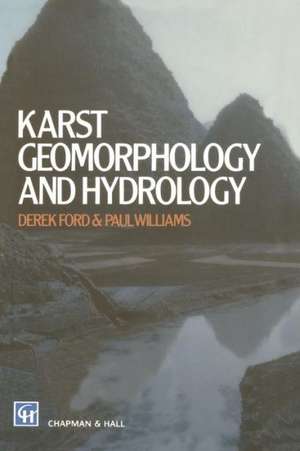Karst Geomorphology and Hydrology
Autor D.C. Ford, P.W. Williamsen Limba Engleză Paperback – 22 iun 2012
Preț: 796.45 lei
Preț vechi: 971.28 lei
-18% Nou
Puncte Express: 1195
Preț estimativ în valută:
152.42€ • 158.54$ • 125.83£
152.42€ • 158.54$ • 125.83£
Carte tipărită la comandă
Livrare economică 14-28 aprilie
Preluare comenzi: 021 569.72.76
Specificații
ISBN-13: 9789401177801
ISBN-10: 9401177805
Pagini: 620
Ilustrații: XV, 601 p.
Dimensiuni: 155 x 235 x 33 mm
Greutate: 0.86 kg
Ediția:Softcover reprint of the original 1st ed. 1989
Editura: SPRINGER NETHERLANDS
Colecția Springer
Locul publicării:Dordrecht, Netherlands
ISBN-10: 9401177805
Pagini: 620
Ilustrații: XV, 601 p.
Dimensiuni: 155 x 235 x 33 mm
Greutate: 0.86 kg
Ediția:Softcover reprint of the original 1st ed. 1989
Editura: SPRINGER NETHERLANDS
Colecția Springer
Locul publicării:Dordrecht, Netherlands
Public țintă
ResearchCuprins
1 Introduction to karst.- 1.1 Definitions.- 1.2 The global distribution of karst.- 1.3 The growth of ideas.- 2 The karst rocks.- 2.1 Carbonate rocks and minerals.- 2.2 Limestone compositions and depositional facies.- 2.3 Diagenesis and metamorphism of limestones; formation of dolomite.- 2.4 The evaporite rocks.- 2.5 Quartzites and siliceous sandstones.- 2.6 Effects of lithologic properties upon karst development.- 2.7 Interbedded clastic rocks.- 2.8 Bedding planes, joints, faults and fracture traces.- 2.9 Fold topography.- 3 Dissolution chemical and kinetic behaviour of the karst rocks.- 3.1 Introduction.- 3.2 Aqueous solutions and chemical equilibria.- 3.3 The dissolution of anhydrite, gypsum and salt.- 3.4 Bicarbonate equilibria and the solution of carbonate rocks.- 3.5 Measurements in the field and lab; computer programs.- 3.6 Chemical complications in carbonate solution.- 3.7 Two examples of the chemical evolution of simple calcium carbonate solutions.- 3.8 Dissolution and precipitation kinetics of the karst rocks.- 4 Distribution and rate of karst denudation.- 4.1 Global variations in the solution of carbonate terrains.- 4.2 Measurement and calculation of solution rates.- 4.3 Solution rates in non-carbonate rocks.- 4.4 Interpretation of measurements.- 5 Karst hydrology.- 5.1 Basic hydrological concepts, terms and definitions.- 5.2 Applicability of Darcy’s law to karst.- 5.3 Controls on the development of karst aquifers.- 5.4 Energy supply for karst aquifer development.- 5.5 The rate of development of flow paths.- 5.6 Classification and characteristics of karst aquifers.- 6 Analysis of karst drainage systems.- 6.1 The ‘grey box’ nature of karst.- 6.2 Exploration and survey techniques.- 6.3 Aquifer zonation and thickness.- 6.4 Borehole analysis.- 6.5 Springhydrograph analysis.- 6.6 Spring chemograph interpretation.- 6.7 Interpretation of the degree of organization of a karst aquifer.- 6.8 Polje hydrograph analysis.- 6.9 Water balance estimation.- 6.10 Water tracing techniques.- 7 Cave systems.- 7.1 Classifying cave systems.- 7.2 Formation of plan patterns of common caves.- 7.3 The common cave systems in depth.- 7.4 System modifications occurring within a single phase.- 7.5 Multi-phase cave systems.- 7.6 Meteoric water caves developed where there is confined circulation or basal injection of water.- 7.7 Hypogene caves A. Hydrothermal caves associated with CO2.- 7.8 Hypogene caves B. Caves formed by waters containing H2S.- 7.9 Sea coast mixing zone cavities.- 7.10 Massive sulphide deposits in karst cavities.- 7.11 Passage cross-sections and smaller features of erosional morphology.- 7.12 Breakdown in caves.- 8 Cave interior deposits.- 8.1 Introduction.- 8.2 Clastic sediments.- 8.3 Calcite, aragonite and other carbonate precipitates.- 8.4 Other cave minerals.- 8.5 Ice in caves.- 8.6 Dating and paleo-environmental analysis of calcite speleothems and other interior deposits.- 8.7 Mass flux through a cave system; the example of Friars Hole, W. Virginia.- 9 Karst landform development in humid regions.- 9.1 Coupled hydrological and geochemical systems.- 9.2 Small scale solution sculpture.- 9.3 Dolines — the ‘diagnostic’ karst landform?.- 9.4 The origin and development of solution dolines.- 9.5 The origin of collapse and subsidence depressions.- 9.6 Morphometric analysis of dolines.- 9.7 Landforms associated with allogenic inputs.- 9.8 Karst poljes.- 9.9 Corrosional plains and shifts in baselevel.- 9.10 Residual hills on karst plains.- 9.11 Depositional and constructional karst features.- 9.12 Sequences of carbonate karstevolution in humid terrains.- 9.13 Special features of evaporite terrains.- 10 The influence of climate, climatic change and other environmental factors on karst development.- 10.1 The precepts of climatic geomorphology.- 10.2 The hot arid extreme.- 10.3 The cold extreme: 1 karst development in glaciated terrains.- 10.4 The cold extreme: 2 karst development in permafrozen terrains.- 10.5 Sea level changes, tectonic movement and implications for the development of coastal karst.- 10.6 Polycyclic and polygenetic karsts.- 10.7 Relict karsts and paleokarsts.- 11 Karst resources, their exploitation and management.- 11.1 Karst hydrogeological mapping and water resources assessment.- 11.2 Pollution of karst aquifers.- 11.3 Problems of construction on and in karst rocks — expect the unexpected!.- 11.4 Urban hydrology of karst.- 11.5 Industrial exploitation of karst rocks and minerals.- 11.6 Recreational and scientific values of karstlands.- References.





